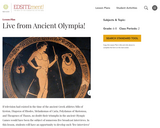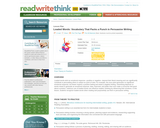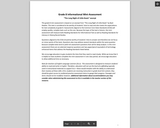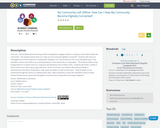
In this lesson and resource, students learn what a thesis statement is and how it relates to an informational reading.
- Subject:
- English Language Arts
- Material Type:
- Lesson Plan
- Provider:
- ProCon.org
- Author:
- ProCon
- Date Added:
- 02/26/2019

In this lesson and resource, students learn what a thesis statement is and how it relates to an informational reading.

Students will have an opportunity to develop such "live interviews" with ancient athletes; working in small groups, they will produce a script based on the results of their research and they will perform the interview for other students in the class.

In this lesson, students recognize loaded words when reading and purposefully use them in persuasive writing.

Students will explore the personalities of the Revolutionary War's Patriots and Loyalists by participating in a character role play. The lesson will culminate with students researching and writing a character sketch of a key Revolutionary figure of their choice and participating in a Colonial Town Hall & Debate.

This PDF allows students to read six nonfiction passages, identify the main idea and text structure, and come up with an appropriate title for each text.

This Achieve the Core 7th grade mini-assessment for The Long Night of the Little Boats by Basil Heater includes the text excerpt, quantitative and qualitative analyses of the text, question annotations, and supplemental materials so that students will experience an indepth understanding of the text.

In this lesson, students will discover how much they can learn from this mixed genre memoir/biography about what inspires life choices.

In this CCSS lesson, students will explore this story through text dependent questions, academic vocabulary, and writing assignments.

In this unit students practice writing to an essential question, using context clues and root words to determine word meaning, close reading with the aid of a glossary, taking notes with graphic organizers, re-reading to answer text dependent questions; and summarizing.

This lesson plan uses graphic organizers to help students create podcasts/ radio broadcasts using a Natural Inquirer article.

This problem-based learning module is designed to engage students in solving a real problem within the community. The question being "How can I help my community get digitally connected? " Students will choose to investigate one of three solutions of making wifi available in our school district to the most populated areas. They will either choose to put Wifi on bus, placing hotspots in the community or using kajeet. The students will be using Google Earth Pro to place circles on a map and calculating the area of these circles. Students will make a model of these circles onto a hard copy using scale factor. At the conclusion, the students will present findings to administration, the board of education, state and local leaders as well as their peers. These findings can be presented through the choice of a display board, flyer, video production or prezi.This blended module includes teacher-led discussion, group-led investigation and discussions along with technology integration.

In this lesson, the students will read and reread the passage closely combined with classroom discussion about it, students will identify why and how farming practices have changed, as well as identify Pollan’s point of view on the subject.

In this CCSS lesson, students will explore this book through text dependent questions, academic vocabulary, and writing assignments.

In this lesson, students will dissect a Times column about the leadership styles of former Vice President (and Nobel Laureate) Al Gore and President George W. Bush and then write their own opinion editorial on presidential leadership.

The objective of this activity is to reinforce the importance of being specific while dealing with events of a sequential nature, such as the phases of the moon.

The students will read and reread the passage closely, and focusing their reading through either a series of questions and discussion about the text or the structured journal approach outlined here, students will come away with a working knowledge of the digestive system, its parts, and how they function together.

Speech writing is a rhetorical art and provides the content for these scaffolded lessons that support the increased cognitive rigor of literacy standards with presidential writings.

This course was created by the Rethink Education Content Development Team. This course is aligned to the NC Standards for 7th Grade English Language Arts.

This course was created by the Rethink Education Content Development Team. This course is aligned to the NC Standards for 7th Grade ELA.

Students summarize a piece of scientific text and assess the advantages, disadvantages and challenges in writing summaries. Students analyze the structure an author gives to a text, comprehending how major sections contribute to the overall understanding of the topic. They then select science-related articles from The New York Times or other scientific publications, and, with a partner, generate summaries of the longer pieces. Teachers vary the text according to their needs.